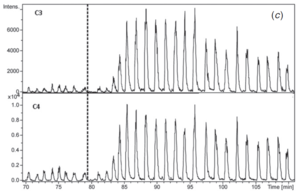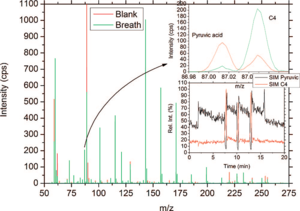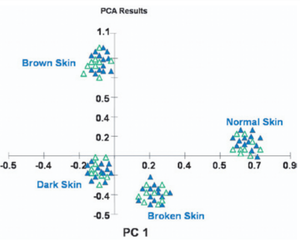Contribution of liquid-phase and gas-phase ionization in extractive electrospray ionization mass spectrometry of primary amines
L. Meier, S. Schmid, C. Berchtold and R. Zenobi
In this study, we investigated how binary mixtures of compounds influence each other's signal intensity in electrospray ionization (ESI), extractive electrospray ionization (EESI) and secondary electrospray ionization (SESI) experiments. The experiments were conducted using a series of homologous primary amines (from 1-butyl to 1- decylamine) …
Characterizing Bacterial Volatiles using Secondary Electrospray Ionization Mass Spectrometry (SESI-MS)
H. D. Bean, J. Zhu, J. E. Hill
Secondary electrospray ionization mass spectrometry (SESI-MS) is a method developed for the rapid detection of volatile compounds, without the need for sample pretreatment. The method was first described by Fenn and colleagues and has been applied to the detection of illicit drugs and explosives, the characterization of skin volatiles, and the analysis of breath.
Real-time, in vivo monitoring and pharmacokinetics of valproic acid via a novel biomarker in exhaled breath
Gerardo Gamez, Liang Zhu, Andreas Disko, Huanwen Chen, Vladimir Azov, Konstantin Chingin, Gunter Kramerb and Renato Zenobi
Valproic acid pharmacokinetics and ingestion in humans can be monitored through a novel biomarker in exhaled breath.
Secondary electrospray ionization-mass spectrometry: breath study on a control group
P. M-L Sinues, L. Zingaro, A. Finiguerra and S. Cristoni
A series of fatty acids among other compounds have recently been detected in breath in real time by secondary electrospray ionization mass spectrometry (SESI-MS). Our main aim in this work was to quantify their abundance in breath calibrating the system with standard vapors and extend the study to a control group for several days, both under fasting conditions and after sucrose intake.
Evaluation of extractive electrospray ionization and atmospheric pressure chemical ionization for the detection of narcotics in breath
C. Berchtold, L. Meier, R. Zenobi
Diagnosis by online breath analysis using mass spectrometry is challenging because of the low concentrations of pertinent compounds in breath. Here we investigate extractive electrospray ionization and atmospheric pressure chemical ionization for the detection of narcotics in breath.
Fast Detection of Volatile Organic Compounds from Bacterial Cultures by Secondary Electrospray Ionization-Mass Spectrometry
J. Zhu, H. D. Bean, Y-M Kuo, and J. E. Hill
We propose a novel application of secondary electrospray ionization-mass spectrometry (SESI-MS) as a real-time clinical diagnostic tool for bacterial infection. It is known that volatile organic compounds (VOCs), produced in different combinations and quantities by bacteria as metabolites, generate characteristic odors for certain bacteria.
Simultaneous sampling of volatile and non-volatile analytes in beer for fast fingerprinting by extractive electrospray ionization mass spectrometry
Liang Zhu, Zhong Hu, G. Gamez, Wai Siang Law, Huan Wen Chen, ShuiPing Yang, Konstantin Chingin, Roman M. Balabin, Rui Wang, TingTing Zhang, R. Zenobi
By gently bubbling nitrogen gas through beer, an effervescent beverage, both volatile and non-volatile compounds can be simultaneously sampled in the form of aerosol. This allows for fast (within seconds) fingerprinting by extractive electrospray ionization mass spectrometry (EESI-MS) in both negative and positive ion mode, without the need for any sample pre-treatment …
Optimisation of secondary electrospray ionisation (SESI) for the trace determination of gas-phase volatile organic compounds
Leonard A. Dillon, Victoria N. Stone, Laura A. Croasdell, Peter R. Fielden, Nicholas J. Goddard and C. L. Paul Thomas
An electrospray ionisation triple quadrupole mass spectrometer (Varian 1200 L) was modified to accept nitrogen samples containing low concentrations of volatile organic compounds. Six candidate probe compounds, methyl decanoate, octan-3-one, 2-ethylhexanoic acid, 1,4-diaminobutane, dimethyl methylphosphonate, and 2,3-butanediol, at concentrations below 50 ppb(v) were generated with permeation tubes in a test atmosphere generator.
Sampling analytes from cheese products for fast detection using neutral desorption extractive electrospray ionization mass spectrometry
Zhongchen Wu, Konstantin Chingin, Huanwen Chen, Liang Zhu, Bin Jia, R. Zenobi
The development of analytical techniques suitable for sensitive, high-throughput, and nondestructive food analysis has been of increasing interest in recent years. In this study, mass-spectral fingerprints of various cheese products were rapidly recorded in the mass range of m/z 50-300 Da without any sample pretreatment, using ND-EESI-MS in negative ion mode.
Detection of Volatile Organic Compounds in Breath Using Thermal Desorption Electrospray Ionization-Ion Mobility-Mass Spectrometry
J. C. Reynolds,* G. J. Blackburn, C. Guallar-Hoyas, V. H. Moll, V. Bocos-Bintintan, G. Kaur-Atwal, M. D. Howdle, E. L. Harry, L. J. Brown, C. S. Creaser, and C. L. P. Thomas
A thermal desorption unit has been interfaced to an electrospray ionization-ion mobility-time-of-flight mass spectrometer. The interface was evaluated using a mixture of six model volatile organic compounds which showed detection limits of <1 ng sample loaded onto a thermal desorption tube packed with Tenax, equivalent to sampled concentrations of 4 μg L−1. Thermal desorption profiles were observed for all of the compounds, and ion mobility-mass spectrometry separations were used to resolve the probe compound responses from each other…
Mass spectrometric study of cutaneous volatiles by secondary electrospray Ionization
P. M-L Sinues
We investigated the volatile organic compounds emanated from the hand of two individuals, on-line by secondary electrospray ionization-mass spectrometry in positive ionization mode. The background ambient air is continuously sampled, ionized and readily mass analyzed. When the probe samples above the headspace of the hand of two subjects, several peaks …
On-line Detection of Human Skin Vapors
P. M-L Sinues, J. F. de la Mora
Vapors released by the skin in the hand of one human subject are detected in real time by sampling them directly from the ambient gas surrounding the hand, ionizing them by secondary electrospray ionization (SESI, via contact with the charged cloud from an electrospray source), and analyzing them in a mass spectrometer with an atmospheric pressure source (API-MS).
Secondary Electrospray Ionization (SESI) of Ambient Vapors for Explosive Detection at Concentrations Below Parts Per Trillion
P. M-L Sinues, J. Rus, G. F. de la Mora, M. Hernández, and J. F. de la Mora
We determine the sensitivity of several commercial atmospheric pressure ionization mass spectrometers towards ambient vapors, ionized by contact with an electrospray of acidified or ammoniated solvent, a technique often referred to as secondary electrospray ionization (SESI).
Neutral desorption sampling of biological surfaces for rapid chemical characterization by extractive electrospray ionization mass spectrometry
H. Chen, R. Zenobi
Extractive electrospray ionization mass spectrometry (EESI-MS) allows the real-time, direct analysis of complex gaseous and liquid samples without any sample pretreatment under ambient conditions. By using a neutral desorption (ND) sampling gas beam to gently impact a surface, the analyte present on a surface can be efficiently sampled and then transported …
Direct Analysis of Fatty Acid Vapors in Breath by Electrospray Ionization and Atmospheric Pressure Ionization-Mass Spectrometry
P. M-L Sinues, J. F. de la Mora
Real time analysis of human breath is achieved in an atmospheric pressure ionization mass spectrometer (API-MS) by negatively charging exhaled vapors via contact with an electrospray cloud. The spectrum observed is dominated by a wide range of deprotonated fatty acids, including saturated chains up to C14. Above C14, the background from cutaneous sources becomes dominant.
Real-time, on-line monitoring of organic chemical reactions using extractive electrospray ionization tandem mass spectrometry
L. Zhu, G. Gamez, H. W. Chen, H. X. Huang, K. Chingin and Renato Zenobi
Extractive electrospray ionization mass spectrometry (EESI-MS) for real-time monitoring of organic chemical reactions was demonstrated for a well-established pharmaceutical process reaction and a widely used acetylation reaction in the presence of a nucleophilic catalyst, 4-dimethylaminopyridine (4-DMAP) …
Rapid classification of perfumes by extractive electrospray ionization mass spectrometry (EESI-MS)
L. Zhu, G. Gamez, H. W. Chen, H. X. Huang, K. Chingin and Renato Zenobi
Extractive electrospray ionization mass spectrometry (EESI-MS) for real-time monitoring of organic chemical reactions was demonstrated for a well-established pharmaceutical process reaction and a widely used acetylation reaction in the presence of a nucleophilic catalyst, 4-dimethylaminopyridine (4-DMAP) …
Direct Analysis of Living Objects by Extractive Electrospray Ionization Mass Spectrometry
H. Chen and R. Zenobi
Spinach contaminated with E. coli leaves 200 people sick in the USA – rapid screening needed for suspected food! Epidemic − thousands of patients need to be rapidly screened in emergencies… What do these and similar headlines have in common? They all challenge modern analytical science in terms of sensitivity, specificity, speed, and especially throughput. It appears that …
Neutral Desorption Sampling of Living Objects for Rapid Analysis by Extractive Electrospray Ionization Mass Spectrometry
H. Chen, S. Yang, A. Wortmann, and R. Zenobi
Mass spectrometry is increasingly used for research purposes and routine measurements in biology, life science, the pharmaceutical industry, and in clinic diagnosis to characterize complex samples. Usually, biological samples are mixtures supported by a biological structure such as skin, tissue, muscle, or vessels and are commonly accompanied by microorganisms …
Neutral desorption sampling coupled to extractive electrospray ionization mass spectrometry for rapid differentiation of biosamples by metabolomic fingerprinting
H. Chen, A. Wortmann, Renato Zenobi
It is of increasing interest and practical importance to develop convenient methods based on mass spectrometry for high-throughput analyses of biological samples. This is usually difficult because of the complex matrix and ion suppression effects. Generation of ions at ambient conditions is a promising solution to these problems …





















